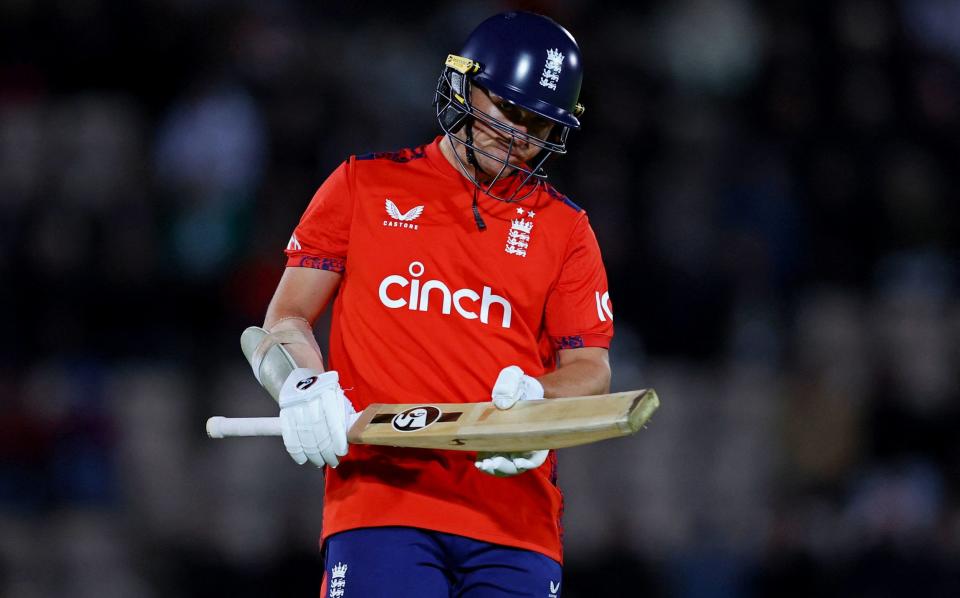
England’s glorious era of white-ball cricket from 2016-22 was underpinned by stellar batting. But for all the focus on those at the top of the order, the threat came from lower down too.
In November 2022, England lifted the T20 World Cup final at the Melbourne Cricket Ground, winning by five wickets with an over to spare. Given the stakes, the chase felt fraught. Yet England did not even need any of Sam Curran, Chris Woakes or Chris Jordan – remarkably, listed at No 10 – to bat.
As they hurtled towards a 28-run defeat in the opening game of the series against Australia, England’s regenerated team had mislaid this identity. Curran – number eight on that heady Melbourne night – batted at six. Either side of him, debutants Jacob Bethell and Jamie Overton both felt like a place too high. At number eight, so did Jofra Archer.
Rather than the 2022 T20 World Cup, England’s line-up brought to mind this year’s ill-fated campaign. In the T20 World Cup semi-final in Guyana in June, England picked Moeen Ali, Sam Curran and Liam Livingstone: three all-rounders in the top seven. The formation gave Jos Buttler abundant bowling options, though Moeen was curiously not used on a turning track. But this came at a cost. England came to regret their decision not to pick an extra batsman, Ben Duckett, as they had discussed before the game.
T20 is a game of resource maximisation. A team’s most important resource is their 120 balls to bat. But their chances of maximising these deliveries hinge on the balance of the side that they select. The greatest error that a side can make in selection is picking players in part for their bowling – and then not using their overs. This weakens a side’s batting, for no gain in bowling.

Yet the opposite is not true. Batsmen who do not face a ball still strengthen a side’s batting – not through what they do, but how they liberate the men above them to attack with more gusto. In the 2022 T20 World Cup final, for instance, Jos Buttler’s attacking in the Powerplay (including an impudent scoop for six off Naseem Shah) ensured that the run rate was always manageable.
A deep batting line-up encourages such early risk-taking. The knowledge of the batting quality to come “gives every single person licence coming in at some point just to really take the game on at all times,” Alex Hales, England’s opener in the 2022 T20 World Cup said in the book White Hot. “When you’ve got 11 guys with that ability, if one or two of you come off, you win the game. That was always the way we felt,” he said.
This depth has been shown to impact how teams bat. When top-order batsmen have the buffer of a useful player coming in at number eight, they attack about 20 per cent more deliveries, research from CricViz finds.
Even within England’s shallow batting line-up in the opening Twenty20 there were curiosities. Sam Curran batted at number six at Southampton. This position ignored how, in all T20 cricket since the start of 2023, Curran averages 28.5 when batting in the top five – yet just 13.1 when batting at six or lower.
Curran’s dire batting record in T20 for England – an average of 13.2 – in part reflects that he has been miscast. If he is to have a long-term T20 international future, Curran’s likeliest route is batting in the top five as an aggressive spin hitter and only bowling when conditions are suitable. In his lone innings for England at four, in the Caribbean last year, Curran hit 50 from 32 deliveries, and could even be promoted there to break up the series of right-handers.

Bethell also appeared misused on Wednesday night, walking out at the start of the seventh over. At this stage in his career he seems best suited to batting at six, as a finisher, replicating his role in the T20 Blast and Hundred.
Yet while the balance of England’s side is dubious, the selectors can also be afforded some sympathy. The schedule prevented England from picking their best possible side. England’s line-up reflected their desire to test out players competing against each other for a berth in their first-choice side. Curran, Bethell, Livingstone and Jamie Overton all played, though England would be likely to field no more than two of the quartet when at full strength.
A more balanced side would have included at least one of James Vince and Tom Banton as extra specialist top-order batsmen. Yet, however well this pair might have done, they have only a slim chance of forcing their way into the full-strength team. The unavailable trio of Jos Buttler, Harry Brook and Jamie Smith – who could all be considered in England’s first-choice team, no matter that Smith is uncapped – would all slot into the top five. Duckett could challenge for a T20 spot too; Ben Stokes might even return to the T20 side.
Building their team in the lead-up to the 2026 T20 World Cup, England’s greatest need is to decide which all-rounders they want, and how to deploy them. The selection in Southampton embraced this priority, but at the expense of deploying players in the roles that they might do for England at full strength.
The balance sacrificed the team’s needs now for those in the future. In theory, this is exactly what bilateral series are for. Yet the sense is growing that, after a chastening two years in white-ball cricket, England would be better served by selecting a side to win now.
Article courtesy of
Source link